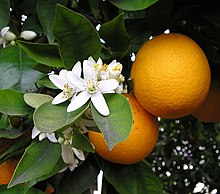Ovary (botany)
Specifically, it is the part of the pistil which holds the ovule(s) and is located above or below or at the point of connection with the base of the petals and sepals.[1][2] Double fertilization of the central cell in the ovule produces the nutritious endosperm tissue that surrounds the developing zygote within the seed.Problems that can arise during the developmental process of the fruit include genetic issues, harsh environmental conditions, and insufficient energy which may be caused by competition for resources between ovaries; any of these situations may prevent maturation of the ovary.Depending on the number of locules in the ovary, fruits can be classified as uni-locular (unilocular), bi-locular, tri-locular or multi-locular.Placental areas occur in various positions, corresponding to various parts of the carpels that make up the ovary.There is no standard correspondence between the valves and the position of the septa; the valves may separate by splitting the septa (septicidal dehiscence), or by spitting between them (loculicidal dehiscence), or the ovary may open in other ways, as through pores or because a cap falls off.A superior ovary is found in types of fleshy fruits such as true berries, drupes, etc.A half-inferior ovary (also known as "half-superior", "subinferior", or "partially inferior") is embedded or surrounded by the receptacle.




pistilflowering plantsgynoeciumpetalssepalscarpelpollenpollen graindouble fertilizationangiospermgymnospermsovulesjuniperzygotecentral cellendospermendozoochoryculinary nutsbotanical nutssimple fruitsaggregate fruitsmultiple fruitsinfructescencesaccessory fruitsreceptaclehypanthiumperianthdrupesinflorescenceLoculesmicropylepollen tubesdehiscentloculePeganum harmalaLunariaandroeciumtrue berriesLythraceaecrape myrtlesPyracanthaorchidsFuchsiaAsteraceaeCucurbitaceaeFruit anatomyBibcodeSoltis, Douglas E.BotanyHistoryOutlineSubdisciplinesArchaeobotanyAstrobotanyBryologyDendrologyEthnobotanyPaleobotanyPhycologyPhytochemistryPhytogeographyGeobotanyPlant anatomyPlant ecologyPlant intelligencePlant pathologyPlant physiologyArchaeplastidaBryophyteNon-vascular plantsVascular plantsLycophyteSpermatophytesGymnospermPlant morphologyglossaryPlant cellsCell wallPhragmoplastPlastidPlasmodesmaVacuoleTissuesGround tissueMeristemStorage organsVascular tissueVascular bundleRhizoidRhizomeCataphyllPetioleSessilityReproductiveArchegoniumAntheridiumStamenAntherStaminodeTapetumFlowerAestivationFlower developmentFloral diagramFloral formulaFloral symmetryAnatomyCapsulePyrenaDispersalGametophyteGynandriumStigmaHypanthium (Floral cup)PedicellateRacemeSporophyllSporophyteCuticleEpicuticular waxEpidermisNectarThorns, spines, and pricklesTrichomeAleuroneApical dominance